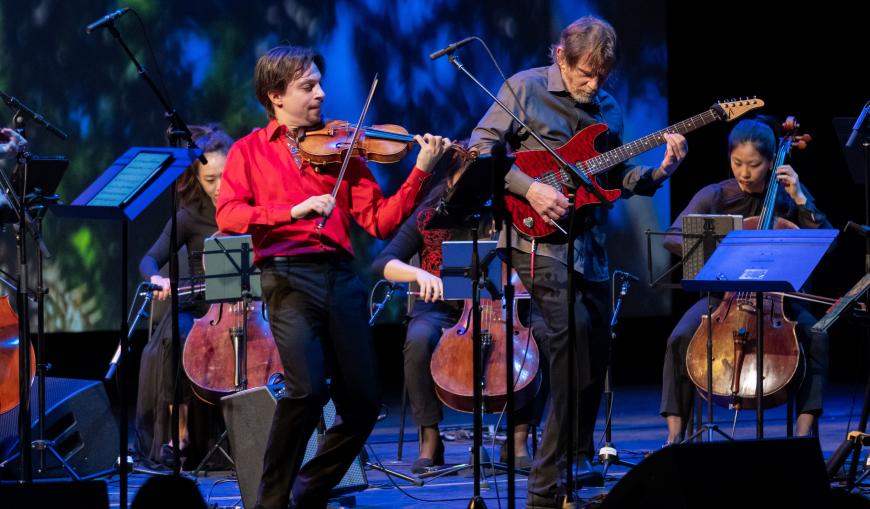After more than two years of development during the COVID pandemic, Treelogy, featuring a trio of nature-themed compositions by Billy Childs, Gabriella Smith, and Steven Mackey, finally had its world premiere Feb. 23 at the Younes and Soraya Nazarian Center for the Performing Arts in Northridge, accompanied by the 16 members of Delirium Musicum.
The spark that ignited the project, The Soraya’s Executive and Artistic Director Thor Steingraber explained during a preconcert panel, was an expansive 2020 article in The New York Times — “They’re Among the World’s Oldest Living Things. The Climate Crisis Is Killing Them,” written by John Branch, with photographs by Max Whittaker.
The article, which Steingraber passed on to violinist Etienne Gara (the artistic director of Delirium Musicum), affected them both deeply. And from that seed the Treelogy project emerged. Three composers would be asked to create 25-minute pieces inspired by the ecological alarm bell sounded by the Times’ reporting. As a focal point, each composer would choose one of the trees cited in the article: the sequoia — Childs’s My Roots Spread Far and Wide (for piano, upright bass, drums, and strings) — the Joshua tree — Smith’s five-movement Desert Ecology (for strings and desert field recording) — and the redwood — Mackey’s Red Wood (for violin, electric guitar, and strings). The performances would also feature Whittaker’s atmospheric, lush green and ashen black smoldering photographs in the background.
Entering The Soraya lobby, it was clear that Treelogy was concerned both with its ecological messaging and the music-making. There were booths advocating action and sustainability set up by TreePeople and the California Wilderness Coalition. There was a related gallery exhibit curated by 11:11 Projects. And rather than the expected composer interviews, Steingraber discussed the origins of the Times article and the ecological impacts of civic policy with Branch, TreePeople CEO Cindy Montañez, and California State Senator Henry Stern before the concert. Even the invocation of welcome by a local tribal elder made the point that we are linked to the land and its management.
Unlike the millennium-long life of the plants in the spotlight, musical compositions are by their very nature ethereal and fleeting. In that sense, Treelogy represents an impressionistic musical experience in three distinct but related movements. The irony is that the composers had no idea what their colleagues were creating.
Not surprisingly, each one played to his or her strengths. Childs, a Grammy Award-winning pianist, combined orchestral passages with the free-flowing improvisational power of his jazz trio: Dan Chmielinski on upright bass and Christian Euman on drums. Straight-ahead jazz sections were interwoven with string passages flavored with Duke Ellington-style harmonies and syncopation and a lush aura that was perhaps too reminiscent of Hollywood panoramas. The result was a patchwork of impressions, many of which blended while others clashed and felt unresolved.
Smith ignited a flurry of intricate string pulsations with Desert Ecology, a work that clearly reflects the influence of John Adams, specifically the rising and falling frenzied energy of Shaker Loops. The wind-swept field recordings added a subtle, expansive sense of the natural environment, while the shifting flutters of the strings mirrored the synchronized flock behavior known as murmuration. Smith also incorporated exceedingly effective use of pizzicato and fingerboard slurs to add a sense of cactus-needle sharpness and the blur of time passing.
Mackey, whose instrument is the electric guitar, created Red Wood as a double concerto in two movements, with himself on lead guitar and Gara as violin soloist. Curiously, in performance Mackey’s guitar seemed to play a secondary, accompanying role. You kept waiting for him to rock out. Gara, on the other hand (having switched into a fiery red shirt), played the rock star to the hilt — a role he clearly relished.
What’s interesting is that while each of the three pieces has its own distinct identity, the themes of nature, trees, the passage of time, and fiery conflagration produced developmental ideas that were surprisingly similar.
All three compositions begin with almost the same atmosphere of dawning anticipation of California forest murmurs and birdcalls (literally in the case of Smith’s field recordings). And in all three pieces, tranquility gives way to a spark that grows into a forest-consuming holocaust.
The endings, however, are distinctly different and personal. Childs’s is like a lyrical elegy. Smith creates a desolate landscape where strings scrape like dying embers while a distant coyote howls at the moon. And if Smith inserts a Vivaldi quotation here and there, Mackey ends his piece with an aura that is part Ralph Vaughan Williams, part Led Zeppelin.
Which brings up the question of amplification. The instruments (except Mackey’s guitar) may not have been cranked up to 11, but they were definitely at rock levels. As a result, the overall sound quality was distinctly metallic and lacking in subtlety of tone. It also made the almost too-perfect execution of the Delirium Musicum musicians feel mechanical rather than personal.
From Northridge, Treelogy, the Billy Childs Trio, and Delirium Musicum head north for concerts Feb. 28 at Chico State’s Laxson Auditorium and March 2 at Sonoma State’s Green Music Center.
